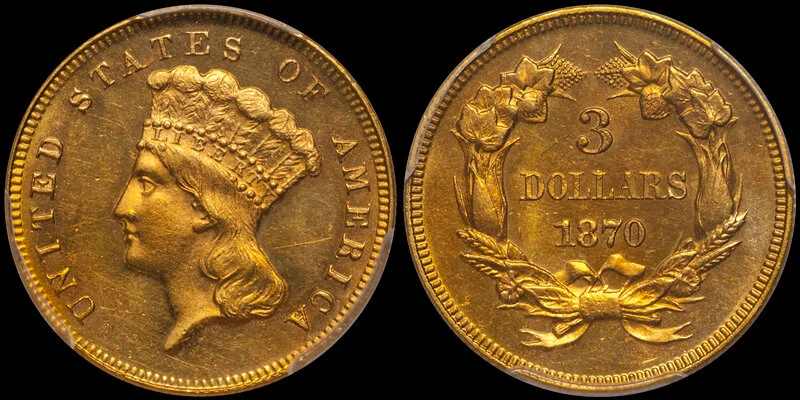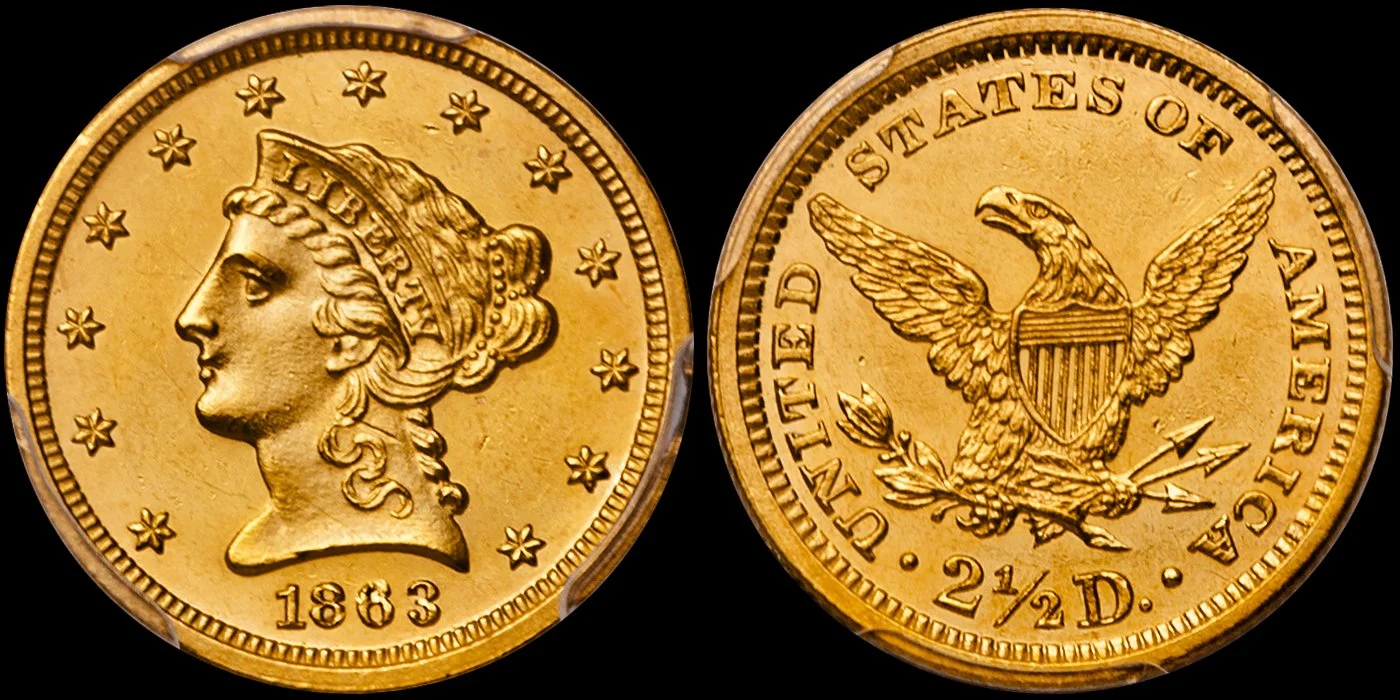Civil War vs. Reconstruction Era Threes in High Grade
/The Three Dollar gold pieces struck during the Civil War are very popular with collectors and sell for significant premiums in higher grades. But, in my opinion, the Reconstruction Era dates are better values; to simplify, we’ll target the 1866 through 1870 so we have the same number of years to compare.
1870 $3.00 PCGS MS63+ CAC
For the sake of our study, we will define “high grade” for these issues as being M63 and finer. Let’s first look at the total number of coins for each group as graded by PCGS in MS63 and above.
| Civil War $3.00s Graded MS63 and Finer by PCGS | |
|---|---|
| DATE | NUMBER GRADED |
| 1861 | 35 |
| 1862 | 23 |
| 1863 | 25 |
| 1864 | 18 |
| 1865 | 9 |
Now let’s view the Reconstruction dates and see how many have been graded MS63 and finer by PCGS.
| Reconstruction $3.00s Graded MS63 and Finer by PCGS | |
|---|---|
| DATE | NUMBER GRADED |
| 1866 | 25 |
| 1867 | 11* |
| 1868 | 42 |
| 1869 | 11 |
| 1870 | 13* |
| *An asterisk means coins designated at PL by PCGS are included in these totals. | |
If we toss the 1861, which seems to me to have been particularly afflicted with resubmissions, and the 1868, which is a hoard date, the numbers favor the Reconstruction issues. The 1865 is the clear winner here, in terms of high grade rarity, with a scant 9 pieces graded MS63 or finer. But the 1867 and the 1869 are not far behind with just 11 graded MS63 or finer by PCGS while the 1870 shows just 13.
1867 $3.00 PCGS MS64
Let’s throw CAC into the mix and try to determine how many of these high grade Three Dollar gold pieces are deemed as acceptable by that service.
| Civil War $3.00s Graded MS63 and Finer and Approved by CAC | |
|---|---|
| DATE | NUMBER APPROVED |
| 1861 | 3 |
| 1862 | 6 |
| 1863 | 5 |
| 1864 | 2 |
| 1865 | 2 |
Now let’s view the Reconstruction dates and see how many were stickered by CAC.
| Reconstruction $3.00s Graded MS63 and Finer and Approved by CAC | |
|---|---|
| DATE | NUMBER APPROVED |
| 1866 | 3 |
| 1867 | 3 |
| 1868 | 8 |
| 1869 | 0 |
| 1870 | 5 |
It is probably not a bad idea to toss the 1868 again. As I mentioned above, this date was hoarded and there are some really nice survivors. But that one date aside, the Reconstruction dates certainly appear as rare—if not rarer—in PCGS/CAC MS63 and finer than their Civil War counterparts.
If you are a collector of high-grade Threes, how should you approach these two groups of coins?
I think you have to be somewhat flexible when it comes to buying these coins. It is certainly an easy request to buy PCGS graded coins exclusively, but what about coins which are NGC graded and CAC approved? Let’s say an NGC/CAC MS63 1869 comes available; an extremely important coin as it would be the very first example of this date to have received a sticker in this grade. If you are comfortable with your grading skills, I’d say it is a no-brainer to buy the coin and to then try and cross it at PCGS.
1866 $3.00 PCGS MS63
What about a scenario where a nice but not CAC-able 1866 graded MS63 by PCGS becomes available? This exact situation occurred recently when I sold a coin in this grade to a sophisticated collector who is working on a PCGS Set Registry of Threes. He bought the coin based on the fact that there are just three MS63 or finer examples of this date currently approved by CAC, and one is an MS66 which is likely to be out of his price range. Given that he is looking for one of the two CAC approved MS63s (certainly needles in a haystack!) he has two viable options: he can wait patiently for a CAC coin in the right grade, or he can fill the hole with a reasonably priced coin and try to eventually “make” a CAC example on his own terms.
The bottom line is that these Reconstruction Era Three Dollar gold pieces are highly undervalued in MS63 and finer, and nearly all are just about impossible to locate in 63 or better with a CAC sticker.
Are you interested in specializing in a set of Three Dollar gold pieces? Why not work with me as I have written the standard reference on this series and know the ins and outs of every date. For more information, please call me at (214) 675-9897 or email me at dwn@ont.com.























